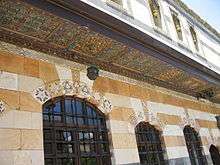As'ad Pasha al-Azm
| As'ad Pasha al-Azm أسعد باشا العظم | |
|---|---|
| Wali of Damascus | |
|
In office 1742–1757 | |
| Monarch |
Mahmud I Osman III |
| Preceded by | Sulayman Pasha al-Azm |
| Succeeded by | Husayn Pasha ibn Makki |
| Wali of Egypt | |
|
In office 1757–1758 | |
| Monarch | Mustafa III |
| Preceded by | Hekimoğlu Ali Pasha |
| Succeeded by | Mehmed Said Pasha |
| Personal details | |
| Died |
March 1758 Mediterranean sea |
| Nationality | Ottoman |
| Relations | Al-Azm family |
| Children | Muhammad Pasha al-Azm |
| Parents | Ismail Pasha al-Azm (father) |
| Religion | Islam |
As'ad Pasha al-Azm (Arabic: أسعد باشا العظم, died March 1758) was the governor of Damascus under Ottoman rule from 1742 to his deposition in 1757. He was responsible for the construction of several architectural works in the city and other places in Syria.[1]
Background
As'ad was the son of Ismail Pasha al-Azm, the founder of the prominent local Arab household, al-Azm, which controlled much the provinces of Ottoman Syria in 1725.[1] One of his brothers was Sa'deddin Pasha al-Azm. As'ad governed Hama as a tax collector for a number of years,[2] until his uncle, Sulayman Pasha al-Azm, governor of Damascus, died in 1743.[1] In Hama, he built the Azm Palace where he resided.[2]
Governor of Damascus
As'ad Pasha succeeded his father as governor of Damascus in 1743. Throughout the first half of the 18th century, the Janissary corps in Damascus challenged the al-Azm family rule in Damascus, but in 1746, As'ad Pasha crushed the local Janissaries. This enabled him to secure his authority in the city.[3]
He was favored by the Ottoman authorities in Istanbul because of his successes in protecting of the Syrian pilgrim caravan that annually left for Mecca and Medina during the Hajj. In his dealings with the Bedouin tribes along the caravan route in the Syrian Desert and the Hejaz, As'ad Pasha either utilized force to subdue them or bought them off. The security of the pilgrim caravan was of prime importance to the Ottoman sultan in his capacity as "Protector of the Two Holy Sanctuaries," especially after the consistent failure of the Janissaries to protect the caravan.[3]

When locust swarms devastated the harvests of interior Syria, As'ad Pasha used it as a pretext to launch raids against Druze communities in the Bekaa Valley, plundering their crops which he placed on the market in Damascus.[4] During his governorship, As'ad Pasha relaxed restraints on Christians; for instance, he allowed them to drink alcohol in public. He used his family's great wealth to construct the Azm Palace in Damascus in 1750. Serving as a joint residence and guesthouse, the palace was a monument to 18th-century Arab architecture.[1] The famed Khan As'ad Pasha was also built under As'ad Pasha's patronage in 1752.[5] His rule represented the apex of al-Azm influence in the Levant as at that time, the members of the family administered Damascus, Aleppo, Hama, Tripoli, Sidon, and for a short period, Mosul.[1]
Despite As'ad Pasha's ability to secure the pilgrim caravan, the new Ottoman authorities in Istanbul deposed him in 1757 after fourteen years of governance. The Grand Vizier at the time, Raghib Pasha, denounced him as a "peasant son of a peasant" after a deal between the two of them faltered. In addition, the Kizlar Agha of Istanbul, Aboukouf, was disdainful toward As'ad Pasha for apparently not catering to him properly when he passed through Damascus as part of the Hajj caravan. The Ottoman state was also interested in confiscating the great wealth As'ad Pasha accumulated during his tenure in office. The large amounts of money collected made the state revalue its currency.[3] As'ad Pasha was initially replaced by Husayn Pasha ibn Makki, a protegé of Aboukouf.[6]
Death
After being deposed, As'ad Pasha was assigned to Aleppo Eyalet and a month after, was appointed Governor of Egypt.[7] In late 1757, the Hajj pilgrim caravan was annihilated. The Ottomans accused As'ad Pasha of inciting the Bedouin to attack the caravan in response to his deposition earlier that year.[3] Consequently, Grand Vizier Raghib Pasha ordered As'ad Pasha's execution.[8] As'ad Pasha was executed in March 1758 aboard a ship ostensibly transporting him to Crete where would live in exile.[7] A Georgian mamluk (slave soldier) of As'ad Pasha, Uthman Pasha al-Kurji, then led Ottoman authorities to the whereabouts of his master's treasures and was rewarded with the governorship of Damascus in 1760.[8]
References
Bibliography
- Carter, Terry; Dunston, Lara; Humphreys, Andrew (2004), Syria & Lebanon, Lonely Planet, ISBN 978-1-86450-333-3
- Choueri, Youssef M. (2005), A Companion to the History of the Middle East, Wiley-Blackwell, ISBN 978-1-4051-0681-8
- Commins, David Dean (2004), Historical dictionary of Syria, Scarecrow Press, ISBN 978-0-8108-4934-1
- Grehan, James (2007), Everyday life & consumer culture in 18th-century Damascus, University of Washington Press, ISBN 978-0-295-98676-0
- Joudah, Ahmad Hasan (1987), Revolt in Palestine in the Eighteenth Century: The Era of Shaykh Zahir Al-ʻUmar, Kingston Press, ISBN 9780940670112
- Ring, Trudy; Salkin, Robert M.; Schellinger, Paul E. (1994), International Dictionary of Historic Places, Taylor & Francis, ISBN 978-1-884964-03-9
- Salzmann, Ariel (2004), Tocqueville in the Ottoman Empire: rival paths to the modern state, BRILL, ISBN 978-90-04-10887-5
| Regnal titles | ||
|---|---|---|
| Preceded by Suleyman Pasha al-Azm |
Wali of Damascus 1742–1757 |
Succeeded by Husayn Pasha ibn Makki |